Customer experience analytics tools are vital for any effective customer experience program. If you're looking to understand your customers further, getting a CX tool in place to help you keep tabs on customer satisfaction can be a game-changer for your strategy.
So, whether you're in the market for a new analytics tool or gearing up to set one up for the first time, this article will guide you through the best customer experience analytics tools to consider in 2024.
What are Customer Experience Analytics Tools?
Customer experience analytics tools are software platforms designed to collect, analyze, and visualize data about customer interactions and feedback. These tools help organizations understand customer behavior, preferences, and pain points throughout the entire customer journey.
For any Insights lead, using these tools is crucial for improving customer experience scores. Imagine having the ability to sift through vast amounts of customer feedback, identifying key trends and insights that can inform your strategies. That’s the power of effective customer experience analytics tools!
Importance of Customer Experience
Customer experience is crucial for businesses as it directly impacts customer loyalty, retention, and ultimately, revenue. A positive customer experience can lead to increased customer satisfaction, advocacy, and loyalty, while a negative experience can result in customer churn and damage to a company’s reputation.
Delivering an exceptional customer experience is essential for businesses to differentiate themselves and stay ahead. By focusing on CX, companies can build stronger customer relationships, reduce churn, and drive long-term growth. Investing in customer experience not only enhances customer satisfaction but also fosters customer loyalty, leading to sustained business success.
Types of Customer Experience Tools
Customer experience tools can be categorized into several types, each serving a unique purpose in enhancing the customer journey:
Customer feedback and survey tools: These tools help businesses collect and analyze customer feedback to identify areas for improvement. They provide insights into customer satisfaction and preferences, enabling companies to make data-driven decisions.
Customer data analytics and management platforms: These solutions enable businesses to collect, analyze, and interpret customer data to gain valuable insights into customer behavior and preferences. They help in understanding the entire customer journey and identifying key trends.
Customer service and support tools: These platforms empower businesses to efficiently manage and resolve customer issues across multiple channels. They enhance customer satisfaction by ensuring timely and effective responses to customer inquiries.
Customer engagement and communication tools: These solutions aid businesses in nurturing strong customer relationships by enabling personalized, targeted, and timely interactions. They help in building customer loyalty and improving overall customer experience.
Experience analytics and personalization engines: These tools leverage data and machine learning algorithms to deliver tailored content, offers, and experiences to individual customers. They enhance customer satisfaction by providing personalized experiences based on customer behavior and preferences.
By utilizing these tools, businesses can gain a comprehensive understanding of their customers, improve customer interactions, and enhance overall customer experience.
10 Best Customer Experience Analytics Tools

1. Kapiche
Kapiche stands out as a leading customer experience analytics tool, leveraging cutting-edge AI technology to help organizations extract actionable insights from customer feedback. With its innovative auto-theming feature, Kapiche allows teams to effortlessly analyze both qualitative and quantitative data, making it an invaluable asset for any organization aiming to enhance its customer feedback analysis.
Best for: Kapiche is particularly suited for companies that want to streamline their insights generation process and quickly identify key trends in customer behaviour. Its ability to aggregate feedback from multiple sources provides a holistic view of customer sentiments.
Notable features:
Auto-theming analysis: Automatically categorizes qualitative feedback into themes, saving time on manual analysis.
Real-time insights: Offers instant access to customer feedback trends, enabling proactive decision-making.
User-friendly interface: Designed for ease of use, allowing teams to quickly navigate and derive insights without extensive training.
Comprehensive data aggregation: Gathers feedback from various sources to provide a 360-degree view of customer experiences.
Pros: Kapiche's powerful analytical capabilities transform complex data into easy-to-understand visualizations, making insights accessible to all team members. The platform’s user-friendly design minimizes the learning curve, allowing teams to focus on actionable insights rather than struggling with the software.
Cons: Some users may face a slight learning curve when exploring the platform's advanced features. While the setup process is generally smooth, it does require an initial investment of time to fully leverage Kapiche’s capabilities.
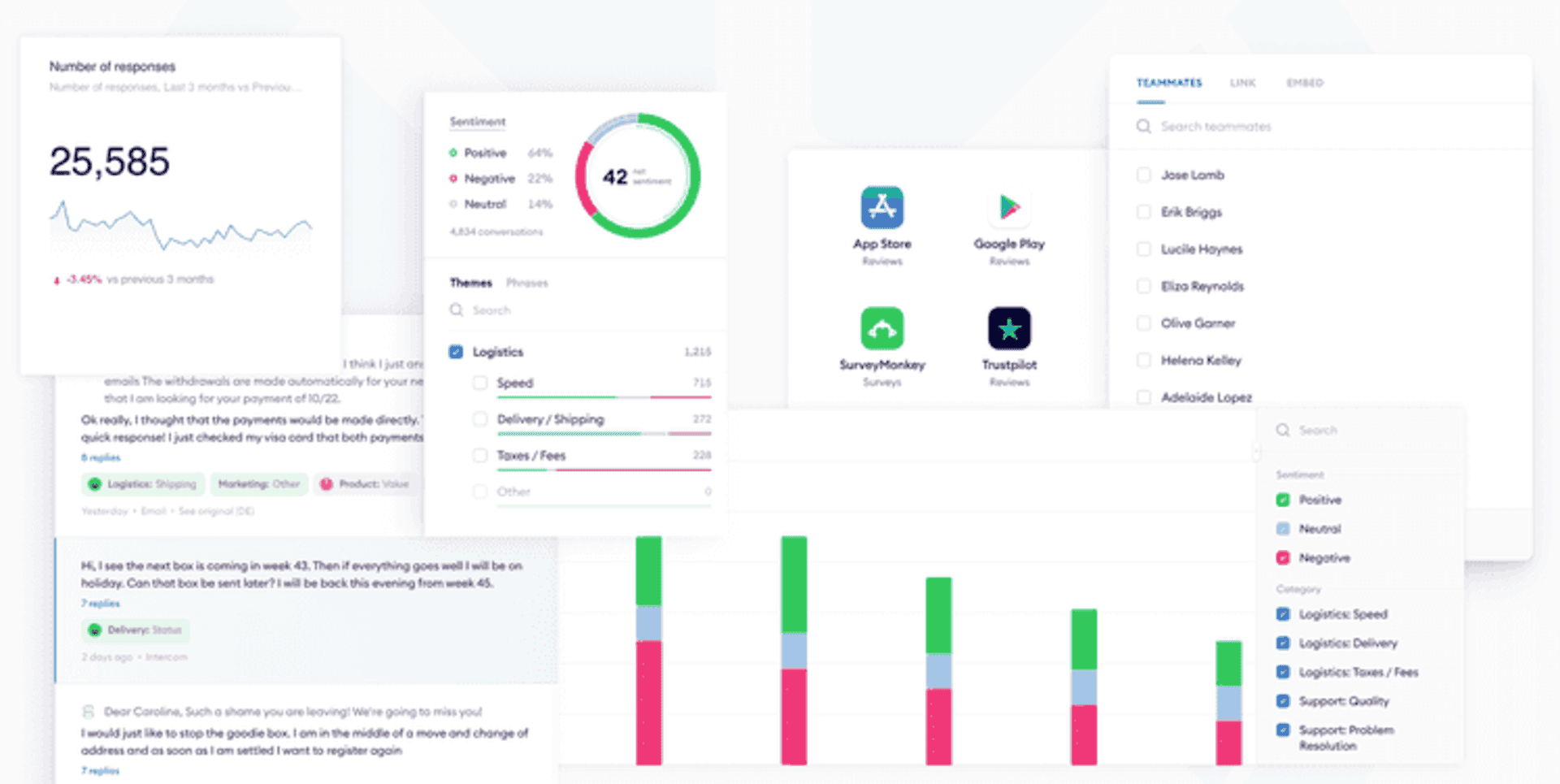
2. Chattermill
Chattermill provides a robust customer experience analytics platform that integrates with various customer feedback channels to extract valuable insights. Its unique feature set focuses on sentiment analysis and text analytics, enabling organizations to understand customer emotions and reactions more deeply.
Best for: Chattermill excels for teams looking to analyze large volumes of open-text feedback across multiple channels. It is particularly useful for businesses aiming to enhance customer satisfaction by understanding emotional drivers behind customer interactions.
Notable features:
Sentiment analysis: Automatically identifies positive, negative, or neutral sentiments in customer feedback.
Custom dashboards: Allows users to create personalized views of key metrics and insights.
Multi-channel integration: Seamlessly connects with various platforms to collect feedback from different sources.
AI-powered insights: Leverages machine learning to identify trends and suggest actionable changes.
Pros: Chattermill’s advanced sentiment analysis offers a nuanced understanding of customer feedback, helping teams identify the underlying emotions in customer interactions. The ability to customize dashboards enhances usability, allowing teams to focus on metrics that matter most.
Cons: Some users may find the pricing on the higher side, especially for smaller businesses. The complexity of advanced features can be overwhelming for those unfamiliar with analytics tools.
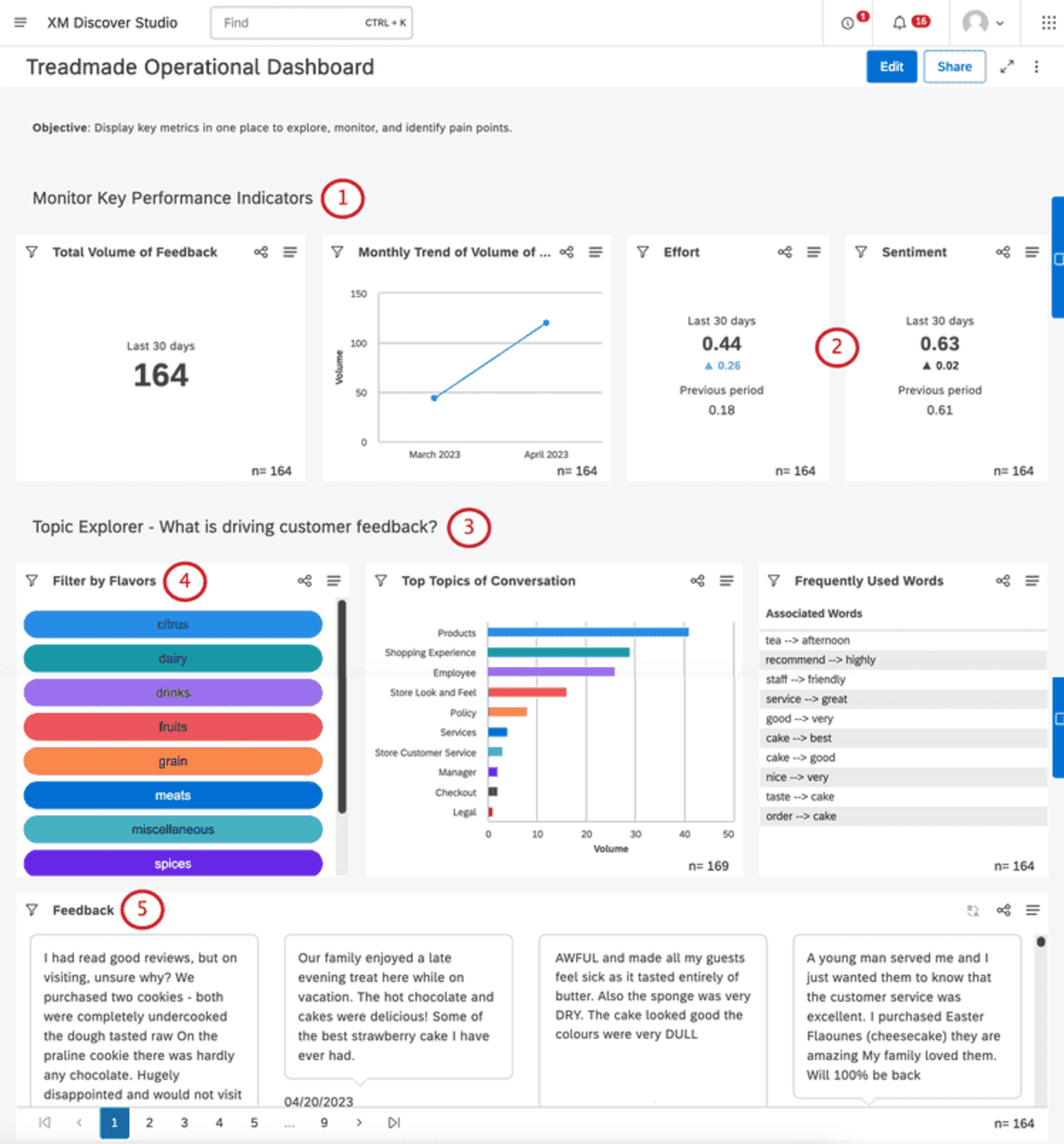
3. Qualtrics
Qualtrics is an experience management platform that enables organizations to gather and analyze customer feedback through comprehensive surveys. It offers a suite of tools designed for measuring customer satisfaction, loyalty, and overall experience.
Best for:Qualtrics is ideal for enterprises looking to conduct in-depth surveys and gain granular insights into customer behavior. Its flexibility makes it suitable for various feedback goals, from NPS to customer satisfaction.
Notable features:
Robust survey builder: Create customized surveys with a variety of question types.
Analytics dashboard: Visualizes data to easily identify trends and insights.
Text analytics: Automatically analyzes open-ended responses for emerging themes.
Integration capabilities: Connects with numerous CRM and marketing platforms for comprehensive data analysis.
Pros: Qualtrics provides a powerful set of survey tools that allow for detailed feedback collection and analysis. Its strong integration capabilities mean that organizations can connect their survey data with other customer data sources for enhanced insights.
Cons: The platform can be complex to navigate for new users, requiring time to master its capabilities. Additionally, the pricing can be prohibitive for smaller organizations or those with limited budgets.
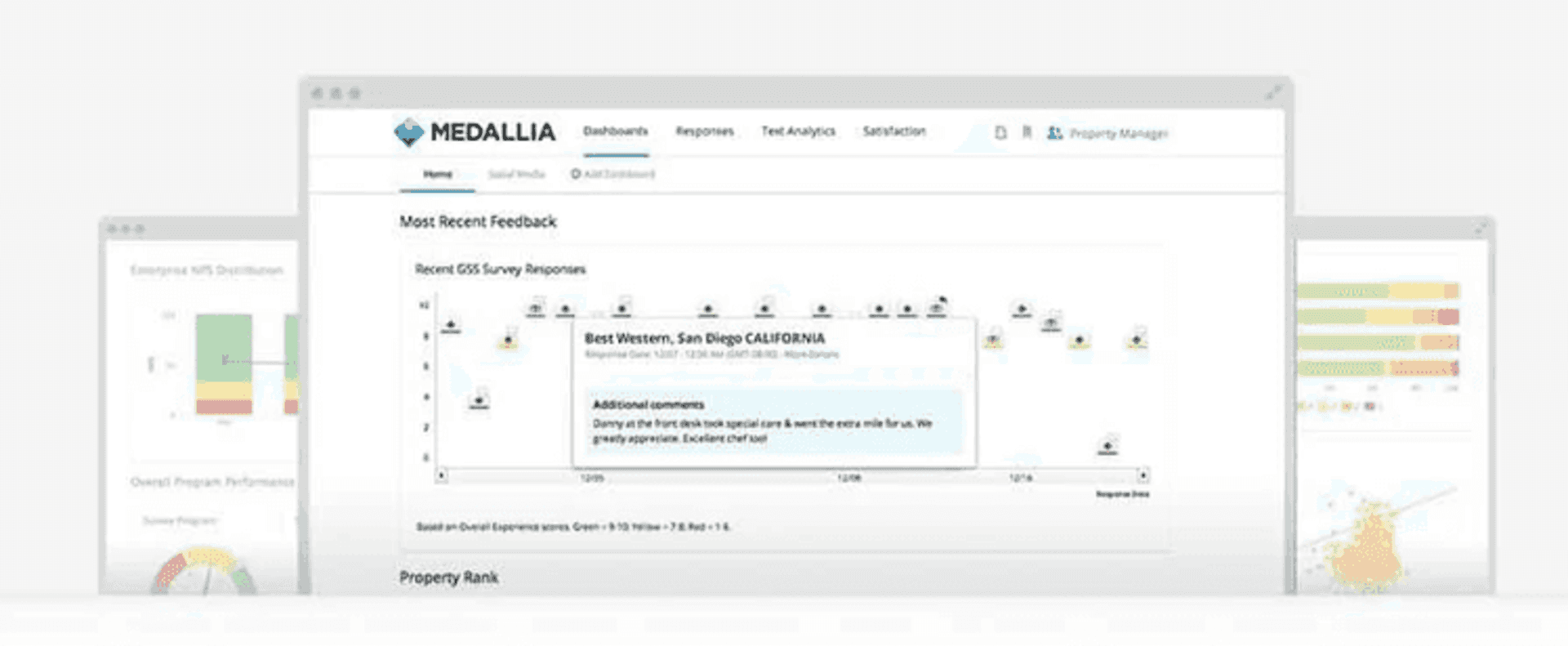
4. Medallia
Medallia is a prominent customer experience analytics tool that captures feedback from multiple touchpoints, helping organizations understand the customer journey in detail. It offers extensive reporting capabilities and real-time insights.
Best for: Medallia is particularly well-suited for large organizations looking to unify customer feedback across various channels. It’s ideal for businesses focused on improving overall customer experience by understanding each step of the customer journey.
Notable features:
Multi-channel feedback collection: Gathers insights from surveys, social media, and direct customer interactions.
Real-time analytics: Provides immediate insights to facilitate swift decision-making.
Integration with existing systems: Easily integrates with other business applications for a comprehensive view.
Customizable reporting: Allows users to tailor reports to meet specific business needs.
Pros: Medallia’s ability to consolidate feedback from diverse sources gives organizations a complete view of the customer experience. The platform’s real-time analytics ensure that insights are timely and actionable.
Cons: The user interface can be overwhelming due to the extensive features available. Smaller teams might find it challenging to utilize the full capabilities of the platform without dedicated resources.
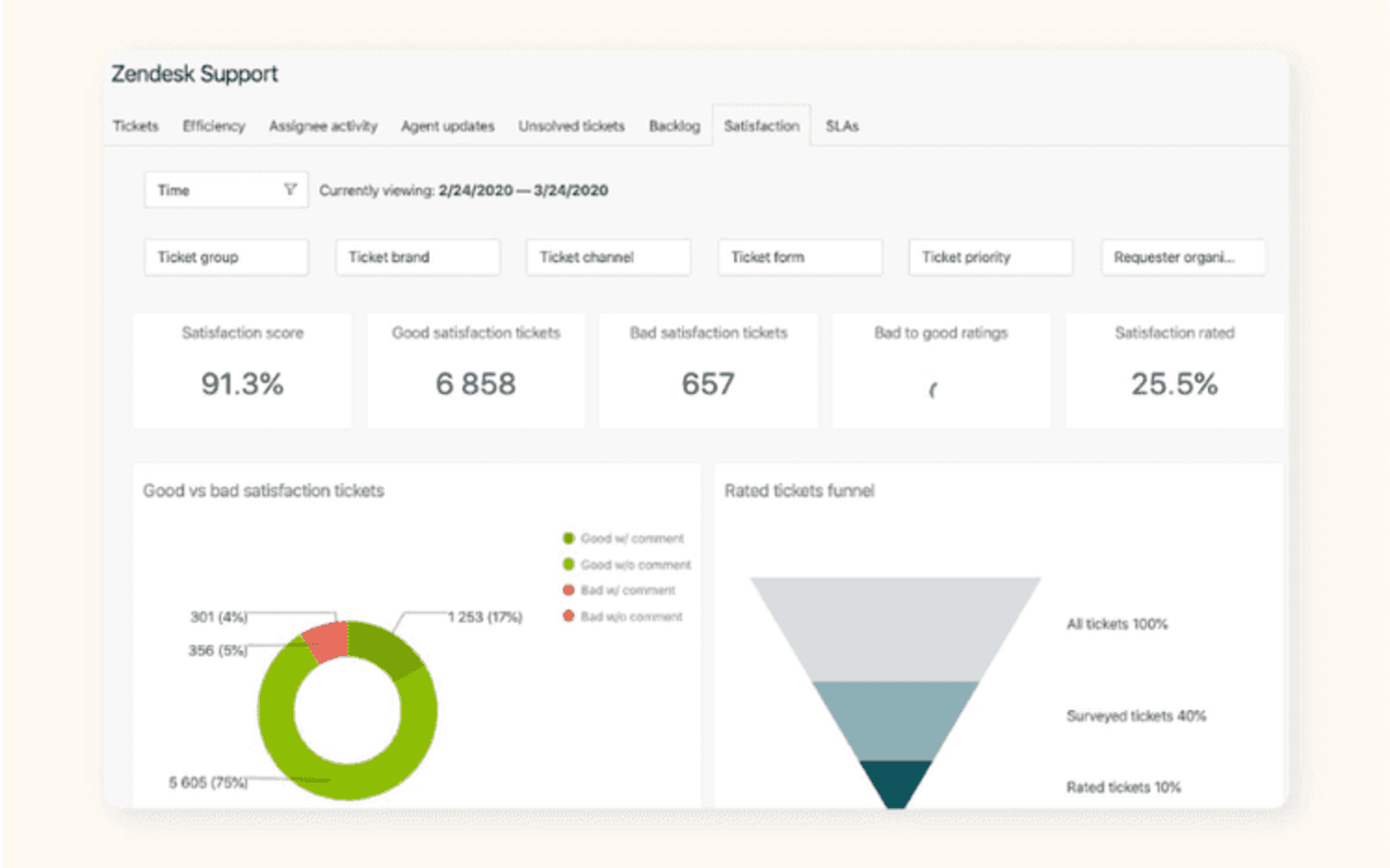
5. Zendesk
Zendesk is widely recognized for its customer support solutions, but it also offers powerful customer experience analytics tools. The platform allows businesses to gather feedback from support interactions, providing valuable insights into customer satisfaction.
Best for: Zendesk is best for companies seeking to improve their customer support experience through feedback analysis. It’s particularly beneficial for teams looking to enhance customer interactions and identify areas for improvement.
Notable features:
Support ticket analysis: Analyzes data from customer support tickets for insights on common issues.
Customer satisfaction surveys: Easily deploy surveys after interactions to gauge satisfaction.
Integrations with other tools: Connects with various applications to enhance data collection.
Real-time reporting: Provides instant access to support metrics and feedback trends.
Pros: Zendesk’s strong integration capabilities and focus on customer support make it a go-to solution for many businesses. The real-time reporting feature ensures that teams can quickly act on feedback.
Cons: While it excels in customer support, Zendesk’s analytics capabilities may not be as comprehensive as dedicated experience analytics platforms. Some users may find the customization options limited compared to competitors.
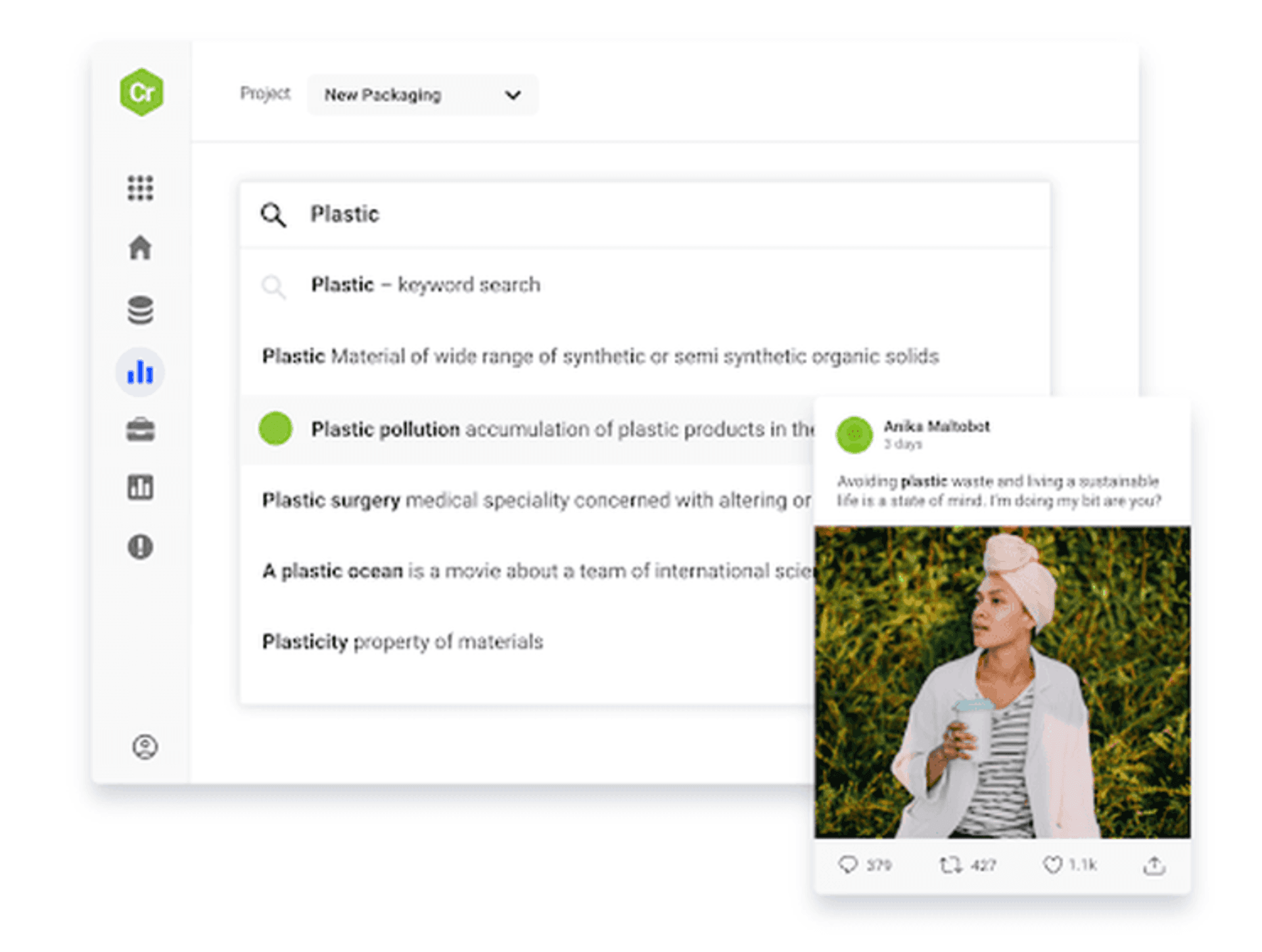
6. UserTesting
UserTesting specializes in gathering user feedback through video recordings and usability tests. This platform provides insights into user behavior and customer experiences with products and services. Digital asset management is also a key component, enhancing user experience and brand consistency across multiple channels.
Best for: UserTesting is ideal for companies looking to understand how customers interact with their products. It’s particularly useful for teams focused on enhancing user experience and optimizing digital assets.
Notable features:
Video feedback: Captures real-time customer reactions and interactions.
Targeted participant recruitment: Allows businesses to select specific demographics for feedback.
Usability testing: Offers structured tests to assess user experience.
Insightful reporting: Generates reports highlighting key insights and user pain points.
Pros: UserTesting’s video feedback feature offers a unique perspective on customer interactions, revealing insights that surveys alone may miss. The platform’s focus on usability testing provides actionable recommendations for product improvement.
Cons: The focus on video feedback may not appeal to all users, particularly those looking for more traditional survey-based insights. Pricing can be a barrier for smaller teams or organizations.

7. Salesforce Service Cloud
Salesforce Service Cloud combines customer support and experience analytics in a single platform, helping organizations manage customer inquiries and feedback effectively. Its comprehensive tools enable businesses to track customer interactions across multiple channels.
Best for: Salesforce Service Cloud is particularly suited for organizations that need a robust solution for managing customer relationships and support inquiries. It's excellent for teams focused on improving service delivery and customer satisfaction.
Notable features:
Omni-channel support: Allows businesses to manage customer interactions across various platforms.
Customizable reporting: Tailors reports to suit specific business needs and metrics.
AI-driven insights: Uses AI to analyze customer data and suggest improvements.
Integration with Salesforce ecosystem: Connects seamlessly with other Salesforce products for enhanced functionality.
Pros: Salesforce Service Cloud offers a comprehensive approach to customer experience management, integrating support with analytics seamlessly. Its strong reporting capabilities allow teams to track performance effectively.
Cons: The platform can be complex and may require a significant investment of time to learn fully. Additionally, pricing can be steep for smaller organizations.
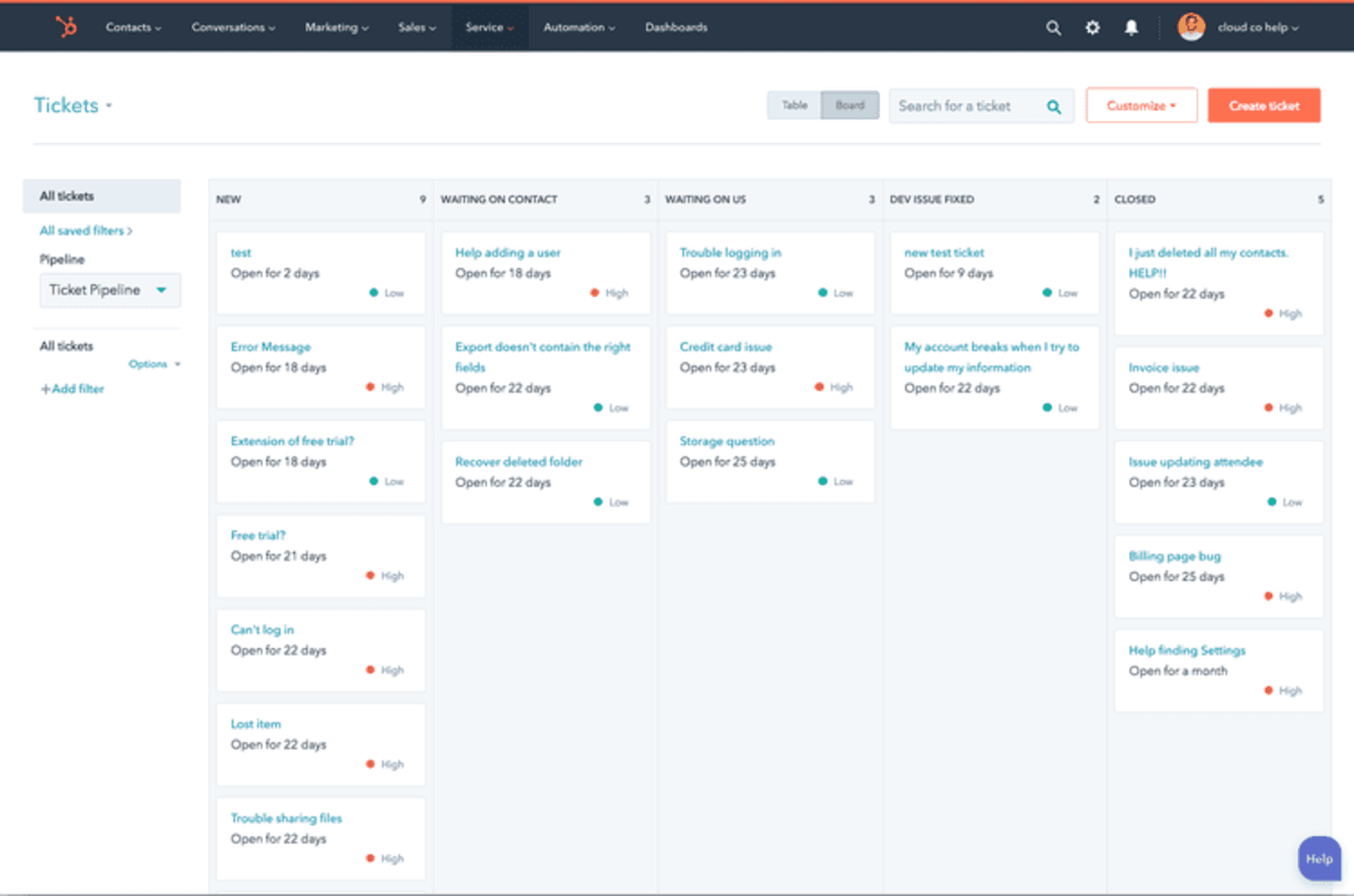
8. HubSpot
HubSpot is renowned for its marketing automation capabilities, but it also offers robust customer experience analytics tools. Its platform helps businesses gather customer feedback and track satisfaction levels through various interactions.
Best for: HubSpot is ideal for small to medium-sized businesses looking to enhance their customer experience through integrated marketing and feedback tools. It's particularly beneficial for organizations focused on lead nurturing and customer retention.
Notable features:
Integrated marketing tools: Combines feedback collection with marketing automation for comprehensive insights.
Customizable surveys: Create surveys tailored to specific customer segments and goals.
Real-time reporting: Provides instant access to feedback metrics and trends.
User-friendly interface: Designed for ease of use, making it accessible for teams without extensive training.
Pros: HubSpot’s integration of marketing and customer feedback tools allows organizations to develop a holistic view of their customers. The platform's user-friendly interface makes it easy for teams to create and analyze surveys without needing extensive technical skills.
Cons: Some advanced features may require higher-tier plans, which can be costly for smaller businesses. Additionally, the extensive capabilities of HubSpot can feel overwhelming to new users.
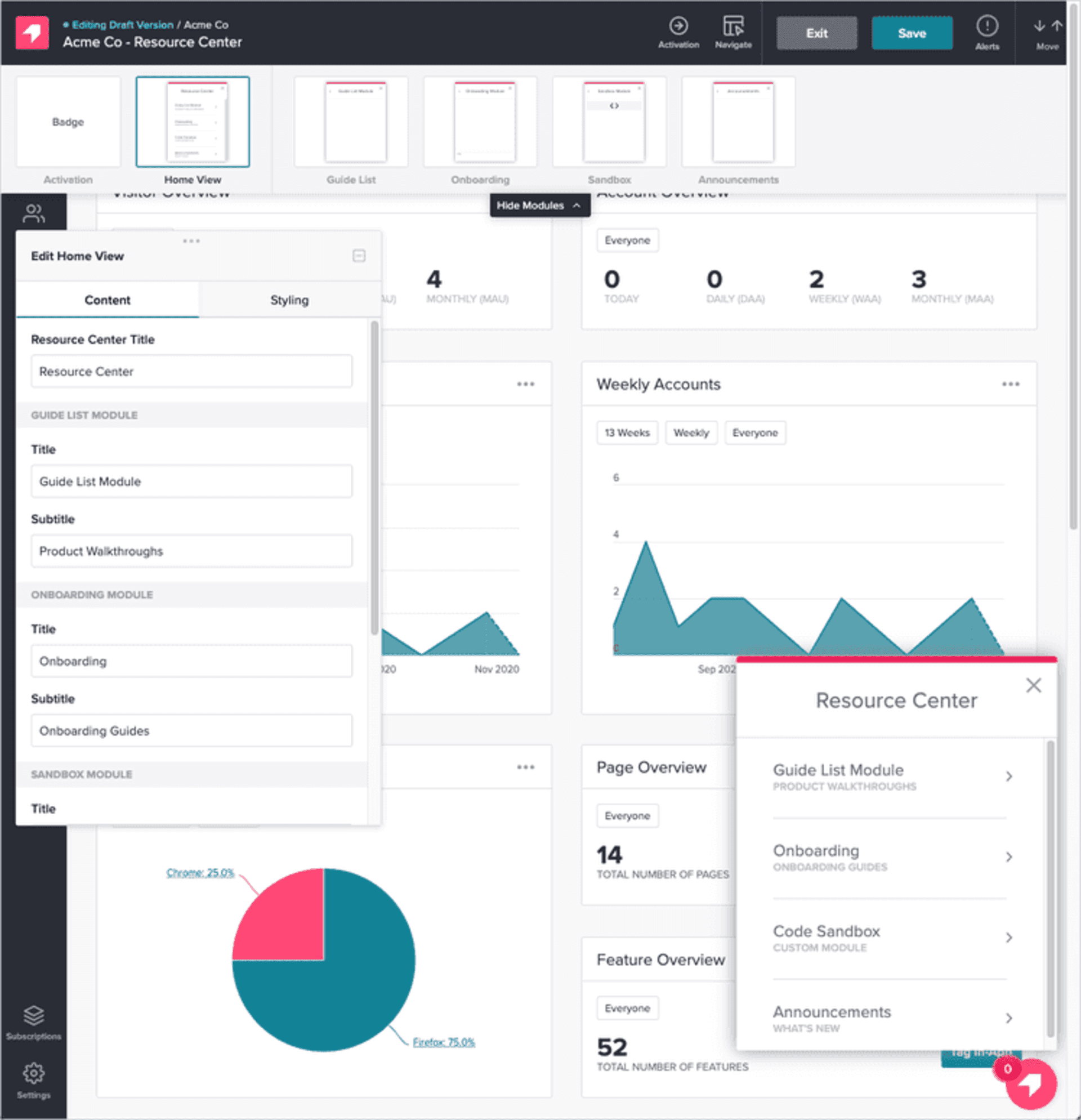
9. Pendo
Pendo specializes in product analytics and user feedback, offering tools to understand customer interactions within software applications. This platform helps teams improve user experience and drive product adoption.
Best for: Pendo is best for product teams looking to enhance user engagement and optimize their software offerings. It's particularly effective for businesses focused on SaaS solutions and digital product experiences.
Notable features:
In-app messaging: Communicates directly with users through messages within the application.
Feature adoption tracking: Measures how customers engage with specific features over time.
User feedback collection: Gathers insights on user satisfaction and needs directly from within the product.
Analytics dashboard: Visualizes user engagement metrics for informed decision-making.
Pros: Pendo's in-app messaging feature allows for real-time communication with users, enhancing engagement and support. The platform’s focus on product analytics provides valuable insights for teams to refine their offerings based on user behavior.
Cons: The primary focus on product analytics may limit its applicability for businesses seeking broader customer experience insights. Additionally, some users may find the setup process for advanced features to be complex.
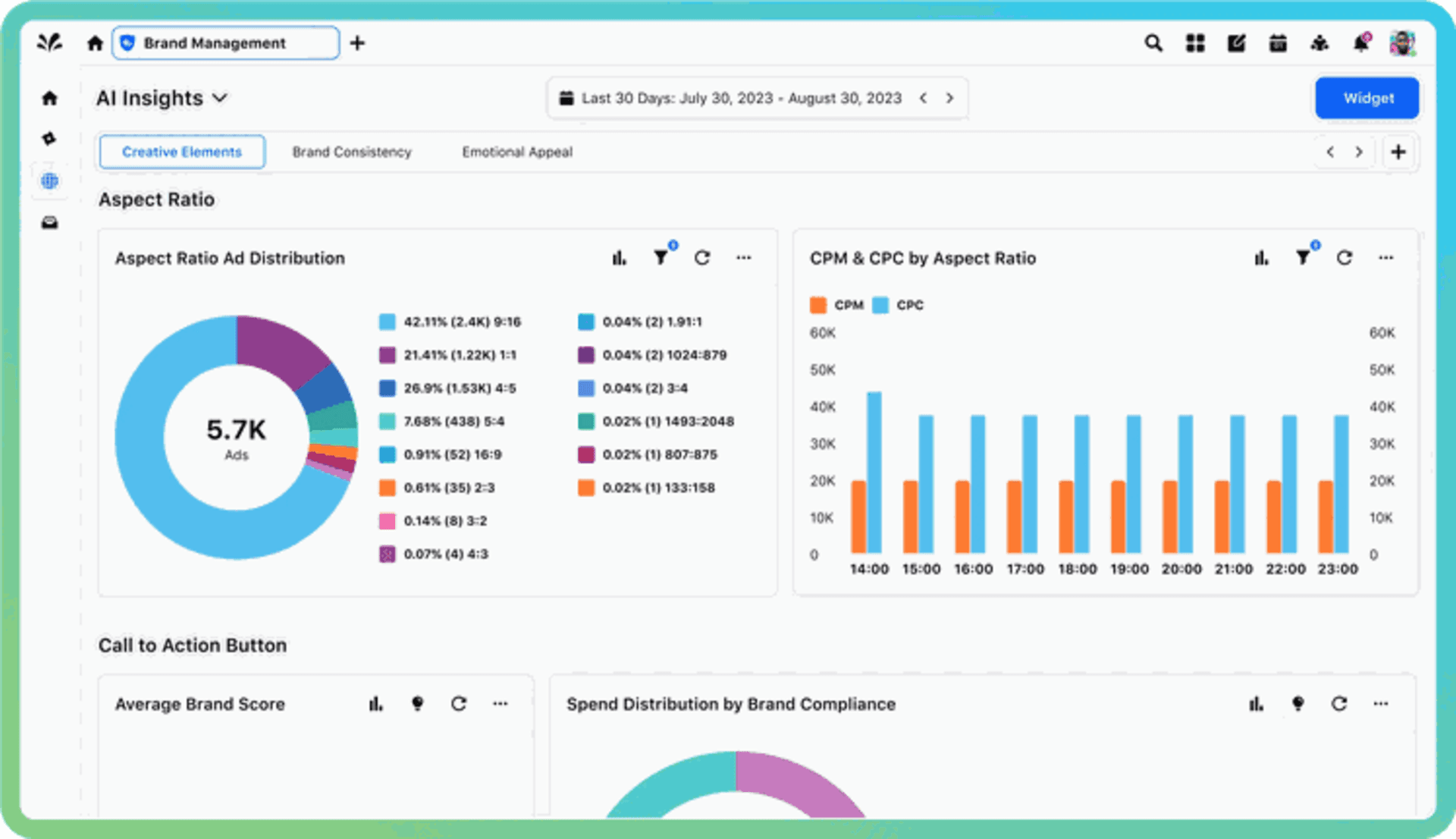
10. Sprinklr
Sprinklr is a unified customer experience management platform that helps organizations manage customer interactions across various channels. It integrates social media monitoring, customer feedback analysis, and marketing automation into a single solution.
Best for: Sprinklr is particularly suitable for large enterprises that want to manage their customer experience across multiple social media and digital channels. It’s ideal for brands aiming to improve customer engagement through integrated feedback strategies.
Notable features:
Multi-channel integration: Collects and analyzes feedback from various digital platforms.
Social media monitoring: Tracks brand sentiment and customer conversations on social media.
AI-driven insights: Utilizes machine learning to uncover trends and patterns in customer behavior.
Custom reporting: Allows users to create tailored reports to analyze key performance metrics.
Pros: Sprinklr’s comprehensive approach to customer experience management ensures organizations can engage customers effectively across various channels. Its AI-driven insights provide actionable recommendations to enhance engagement strategies.
Cons: The complexity of the platform may be overwhelming for smaller teams or organizations new to customer experience analytics. Additionally, the pricing structure can be a barrier for smaller companies looking to adopt the platform.

Benefits of Customer Experience Management
Effective customer experience management can bring a ton of benefits to businesses, including:
Increased customer satisfaction and loyalty: By understanding and addressing customer needs, businesses can enhance customer satisfaction and foster loyalty.
Improved customer retention and reduced churn: A positive customer experience encourages customers to stay with a brand, reducing churn rates.
Enhanced customer insights and understanding: Customer experience management tools provide valuable insights into customer behavior and preferences, enabling businesses to make informed decisions.
Increased revenue and growth: Satisfied and loyal customers are more likely to make repeat purchases and recommend the brand to others, driving revenue growth.
Competitive differentiation and market leadership: Delivering an exceptional customer experience sets businesses apart from competitors and positions them as market leaders.
Improved operational efficiency and reduced costs: By streamlining customer interactions and resolving issues efficiently, businesses can reduce operational costs and improve overall efficiency.







